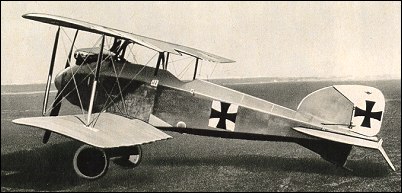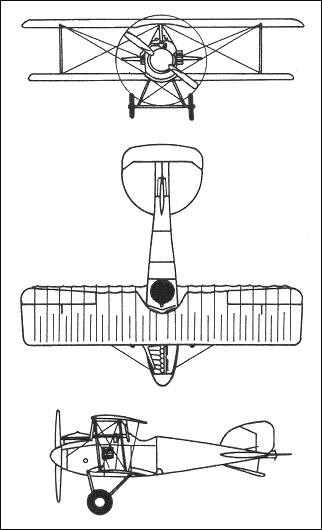|
| Designed by Herren Thelen, Schubert and Gnadig in a
successful endeavour to wrest from the Allies the aerial
superiority gained over the Fokker monoplanes by the
Nieuport 11 Bebe and the Airco D.H.2, D.I was the first
fighter to be developed by the Albatros-Werke. Introduced
in August 1916 were 12 pre-series aircraft. Aerodynamically clean for its time, the
D.I had a semi-monocoque wooden fuselage which differed
radically from the fabric-skinned, braced box-girder
type fuselages then in almost universal use. The
wings were conventional fabric-covered wooden structures,
the power plant was either the 150hp Benz Bz III
or 160hp Mercedes DIII six-cylinder inline water-cooled
engine, and armament consisted of paired
7.92mm LMG 08/15 synchronised machine guns. Fifty
series D.Is were ordered in July 1916, and these were
delivered to the Front (where 50 pre-series and series D.Is were in service in November), but no further production
of this fighter was undertaken as the D.I had
been overtaken by the D.II which, in fact, arrived at the
Front at the same time as the earlier type.
| CREW | 1 |
| ENGINE | 1 x Mc D III, 125kW |
| WEIGHTS |
| Take-off weight | 900 kg | 1984 lb |
| Empty weight | 674 kg | 1486 lb |
| DIMENSIONS |
| Wingspan | 8.5 m | 28 ft 11 in |
| Length | 7.4 m | 24 ft 3 in |
| Height | 3.0 m | 10 ft 10 in |
| Wing area | 22.9 m2 | 246.49 sq ft |
| PERFORMANCE |
| Max. speed | 175 km/h | 109 mph |
| Ceiling | 6000 m | 19700 ft |
| Range w/max.fuel | 300 km | 186 miles |
| ARMAMENT | 2 x 7.92mm |
| Klaatu83, e-mail, 29.10.2011 20:47 The introduction of the Albatros D-I, with it's excellent performance and twin machine guns, was a true landmark in fighter development. In only principal changes in the succeeding D-II were that the top wing was lowered slightly, at the suggestion of combat pilots, and the radiator moved to the upper wing, both in an effort to improve pilot visibility from the cockpit. The D-III introduced a narrower single-spar lower wing, inspired by that of the French Nieuport fighters, to further improve downward visibility. Unfortunately, however, the single-spar lower sing also weakened the wing structure, with sometimes disastrous results. The D-V was little more than a refined version of the D-III. reply |
| ...., 09.12.2010 22:46 When did this plane go out of service? reply | | alexander, e-mail, 16.10.2010 23:25 awesome plane for a history report reply | | Matthew, e-mail, 23.03.2010 08:31 great improvement on the allied planes. reply | |
| | hugo perez, 12.03.2009 00:36 no i do not have a comment about this aircraft!
it was my favorite though! reply |
| FMB42, 28.10.2008 16:49 Robert Thelen and his design team produced this fighter. reply | | Danille, e-mail, 20.05.2008 03:41 who was the engineer who invented this design? reply |
|
Do you have any comments?
|
| 
COMPANY
PROFILE
All the World's Rotorcraft
|







 Klaatu83
Klaatu83
20
reply